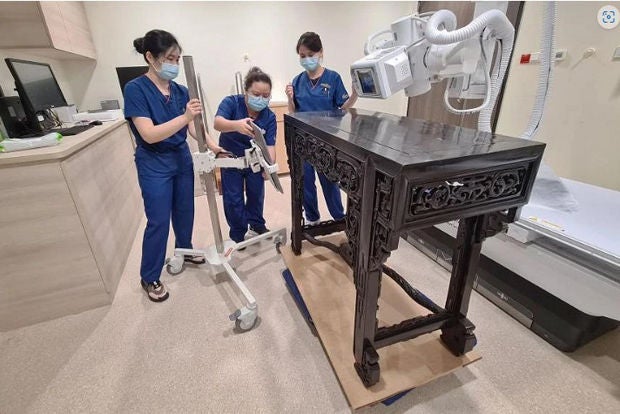
Sidetables from Panglima Prang, the ancestral home of Tan Kim Seng, undergoing X-ray scans at SGH on Nov 26, 2022. ST PHOTO: FELINE LIM
SINGAPORE – Two unexpected “patients” made their way to the Singapore General Hospital (SGH) in November, their weight requiring two grown men to move and their fragility a source of concern for all involved.
Both a century old, they were at the hospital for X-ray scans. Their joints were thought to require further examination, so a three-hour slot had been booked on their behalf.
The “patients” were, in fact, tables from a famous Peranakan bungalow here, Panglima Prang, home of 19th-century merchant and philanthropist Tan Kim Seng.
Conservators had requested that they be scanned to better understand whether the objects had been refurbished or restored.
The scans are part of preparations for the reopening of the Peranakan Museum in 2023.
The museum in Armenian Street was closed for redevelopment in 2019.
The Peranakan Museum’s curator Dominic Low says: “The scans allow curators and conservators to observe, compare their construction and assess the conservation required for the two objects without dismantling them.”
The tables will be displayed in the three-storey museum, although one of them will be rotated into the gallery later, as it requires more treatment for now.
Mr Low says the tables were probably made in the early 20th century.
“Such side tables would have been made in pairs and placed facing each other on either side of the reception hall of a Peranakan household.”
The two ornate tables are indicative of the Tan family’s wealth, which was derived mostly through the spice trade from the 19th century. They are decorated with auspicious motifs such as dragon heads and clouds. Proud Chinese lions sit at the centre of each stretcher between the tables’ four legs.
Ms Birte Koehler, senior conservator of objects at the Heritage Conservation Centre, scanned the major and more complex joints, such as the tabletop and the bottoms of the table feet.
With the help of SGH radiographers, scans revealed that the two tables’ construction were broadly similar, though “there were indications of possible repair for typical weak areas, such as the feet”.
Ms Koehler adds: “X-ray images easily reveal differences between contrasting materials such as wood and metal. However, shading differences may be more subtle between materials of the same nature, such as different woods.
“Uneven layering of material due to the presence of carvings and complex joints may also pose challenges in capturing defined X-ray images.

Watch video: https://youtu.be/h6laEaVwDrE
The information derived from scans allows conservators to better recommend conservation treatment, especially if they reveal that earlier touches have significantly altered objects’ appearances or led to their deterioration, she says.
This might also give them a better understanding of the material used in an item’s construction, allowing conservators to better place its country of origin. For example, teak would hint at South-east Asia, while mahogany or walnut might point towards China.
Ms Koehler says: “Accumulating and assessing information across a combination of scientific, technical, art historical and social context studies would contribute to a better understanding of the whole picture.”
The Heritage Conservation Centre, which houses and restores Singapore’s national collection of artefacts, has been working with SGH to X-ray these artefacts since 2014.
X-rays are sometimes also used for paintings, peeling back the layers to reveal overpainting or the extent of paint loss over time.

Conservators had requested that the tables be scanned to better understand if the objects had been refurbished or restored, and to place their country of origin. ST PHOTO: FELINE LIM
Mr Anthony Lau, the Heritage Conservation Centre’s senior conservator of paintings, says X-rays can sometimes also show pentimento (an artist’s alteration) or painting techniques, such as by determining whether paints contain heavy metals like lead and mercury.
Asked why the centre does not have its own X-ray machine, Mr Lau cites cost concerns, as well as maintenance and the need to use it frequently. There are also stringent licensing regulations in place for the buying and operating of X-ray machines, as well as certification for users.
Contributed by














 Get it on Google Play
Get it on Google Play